The influencer market is crowded. Just scroll TikTok or Instagram, and you’ll see it: everyone’s selling something, collaborating with someone, or pushing content that feels vaguely brand-sponsored.
But here’s the real question: are you just throwing money at creators and hoping for the best, or do you have a system to make those dollars work?
That’s where the 3 R’s of influencer marketing come in.
Reach, relevance, and resonance: this simple framework helps you determine which influencers are worth investing in, before you waste your budget on someone who looks good but doesn’t move the needle.
And brands are getting serious returns from this approach. Businesses see an average of $6.50 in revenue for every $1 invested in influencer marketing if that influencer marketing strategy is done well.
In this article, we’ll break down what each “R” really means, when to prioritize each one, and how to build influencer campaigns that increase your ROAS.
TL;DR
Short on time? Here's what you need to know:
- The 3 R’s = Reach, Relevance, and Resonance. Use them to vet creators smartly.
- Most marketers obsess over reach, but relevance and resonance drive actual conversions.
- This framework reduces campaign risk, aligns your team, and scales better than gut-feel picks.
- Reach = visibility. Relevance = fit. Resonance = influence power.
- Apply the right “R” based on your funnel stage; don’t treat all campaigns the same.
- inBeat Agency helps you track key metrics for each “R”.
- Real brands (like Soylent, NielsenIQ, and LoopBeats) are already doing this, and winning.
Why Care About the 3 R’s of Influencer Marketing?
Most marketers chase numbers: large follower counts, extensive reach, and numerous impressions. But here’s the thing: visibility alone doesn’t equal results.
- Reach without relevance means wasted impressions.
- Reach without resonance means no real influence.
When you use the 3 R’s to vet creators, you’re not just building a list of “cool” influencers; instead, you’re building a repeatable system. One that:
- Cuts down on campaign waste.
- Aligns your team on who fits.
- Scales better when you’re managing 10, 20, or 100+ partnerships.
But it’s not ROI that matters only, according to HubSpot's 2025 Social Media Marketing Report, the top reasons brands double down on community-building include:
- Improving brand loyalty (30%)
- Gaining followers (28%)
- Driving more UGC (24%)
- Growing brand awareness (24%)
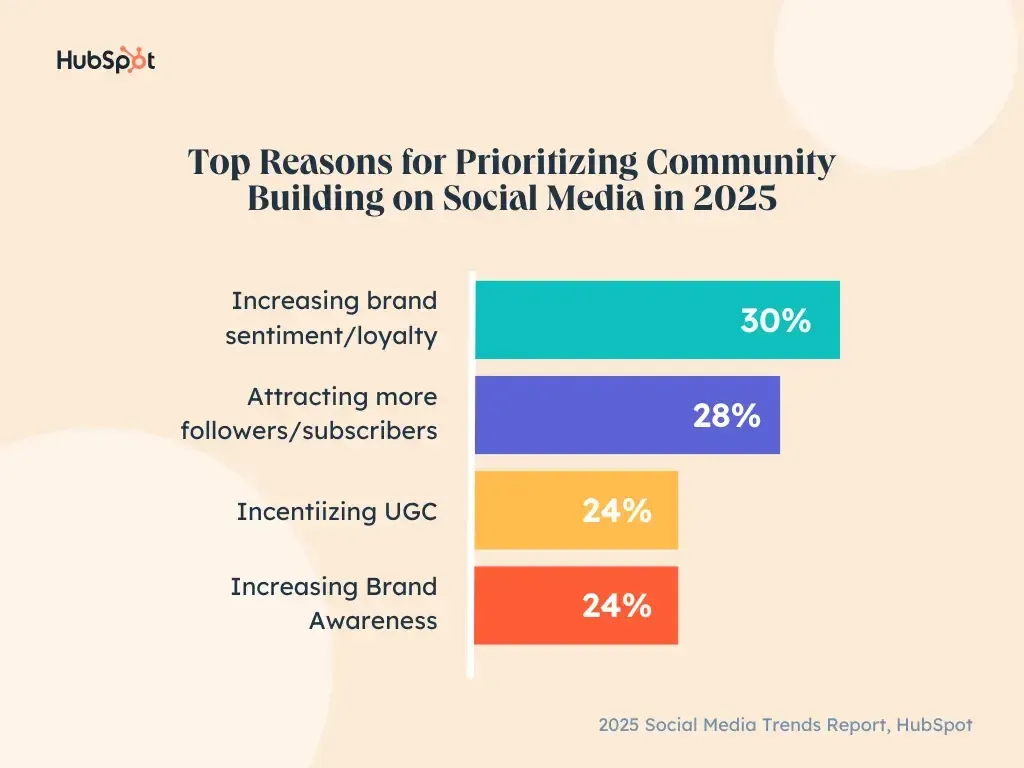
The strategy is to pick the right creators, and not just the loudest ones.
What Are the 3 R’s of Influencer Marketing?
Think of the 3 R’s as a quick filter before you even start DMing creators or pulling together your influencer shortlist.
Here’s how each one works and when to lean on it.
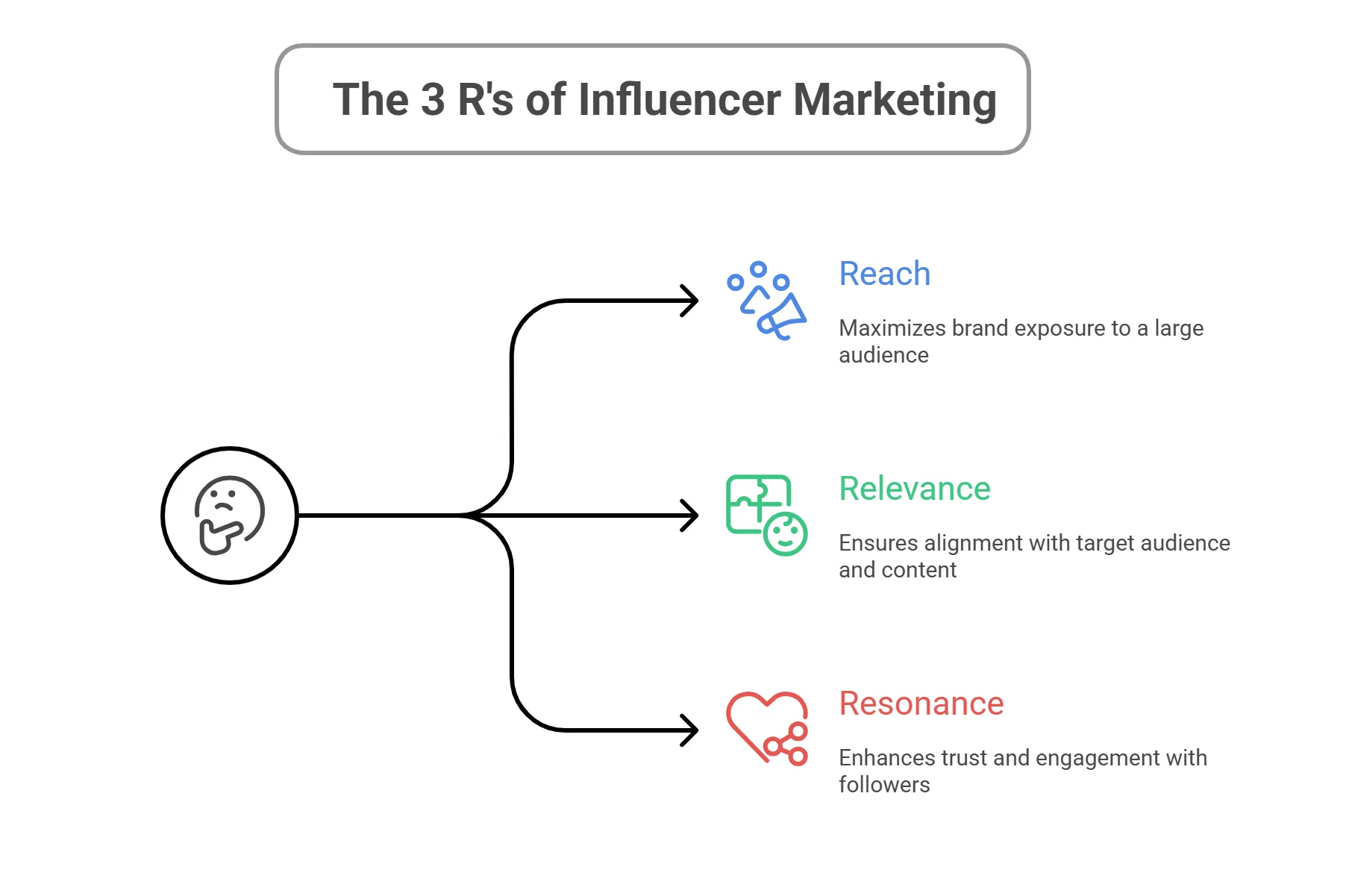
1. Reach
Reach is the most obvious one: it’s about audience size and content visibility.
We’re talking follower count, average impressions, and how many eyes see their posts. But reach can be misleading; just because someone has 200K followers doesn’t mean they’re driving actual impact.
Fake followers, ghost engagement, low viewership… It’s a thing.
Here’s what to look at:
- Follower base.
- Platform reach (average post reach vs. follower count).
- Impressions per post.
- Reach rate (especially on Stories or Reels).
At inBeat Agency, we centralize audience count as well as other influencer metrics to have the complete picture about them:
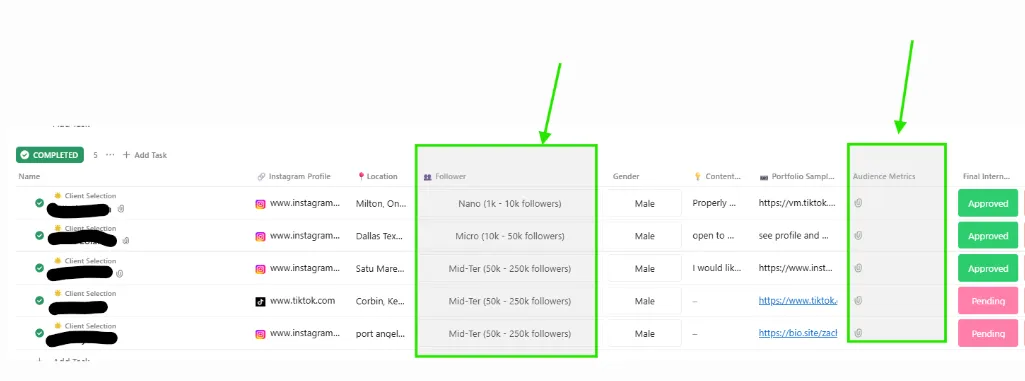
Reach matters most in moments like these:
- Top-of-funnel campaigns.
- Brand awareness plays.
- PR moments when exposure matters more than clicks.
2. Relevance
Relevance is about fit. You’ll be making sure the creator’s audience, content, and tone align with your brand and speak directly to the people you’re trying to reach.
It’s where brands either strike gold or end up in a thread called “Worst Brand Collabs of the Year.”
You’ll be looking at:
- Audience demographics (age, location, interests).
- Past brand collaborations (especially in your niche).
- Brand values and tone alignment.
- Content style (does their feed look like your customer would vibe with it?).
When it’s important to focus on relevance:
- Product seeding campaigns.
- SaaS or vertical-specific DTC launches.
- Any UGC partnerships where brand fit is critical.
Key Stat: As noted by Social Cat, campaigns with niche-aligned influencers see 13.59% more engagement and 81.39% more views. This is proof that the right fit drives real results.
3. Resonance
It’s how well an influencer moves their audience, not just entertains or shows up in the feed. Anyone can post, but resonance is when people care. They save the post, tag a friend, ask questions, and trust the recommendation enough to click “Buy.”
High resonance shows up in:
- Thoughtful comments (not just emoji reactions).
- Shares and saves (signals the content hit a nerve).
- Replies to Stories or DMs asking for more info.
- Followers acting on the content: clicks, signups, purchases
That’s why an influencer with 10K followers and loyal fans can often outperform one with 500K passive lurkers.
Fitness influencer Mitch Little offers a good example; you can immediately see that his fun content engages his audience by how people reply:
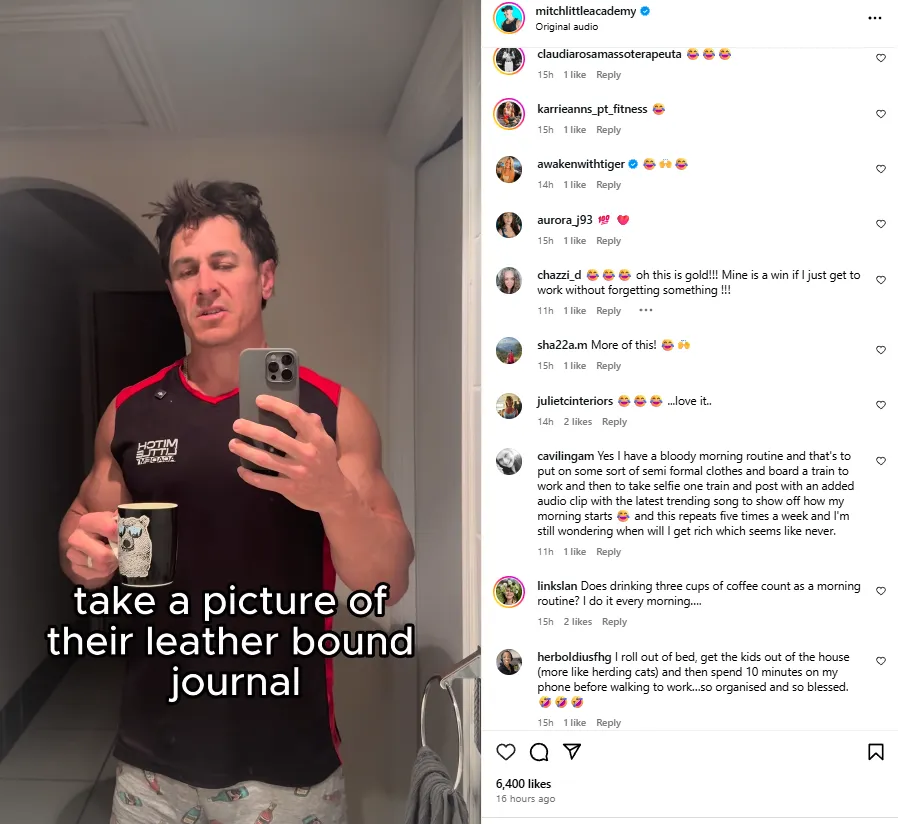
You should prioritize resonance when:
- You need conversions and not just clicks.
- Running performance campaigns with direct attribution.
- Building long-term creator partnerships.
- Licensing UGC for ads.
Key Stat: As Social Cat also reports, micro-influencers (10K–50K followers) average 1.81% engagement, which is 46% higher than mid-tier creators. That’s a clear sign that smaller, focused audiences often deliver a bigger impact.
How to Optimize the 3 R’s of Influencer Marketing
Understanding the 3 R’s is one thing, but applying them where they count is where the real value kicks in.
Optimizing the 3 R’s means you stop picking influencers based on gut instinct or how nice their feed looks, and start selecting based on real impact. It’s about building partnerships that make sense strategically, so you’re not just generating content, you’re driving measurable results.
At inBeat, we’ve worked with brands across industries, and the pattern holds: the best campaigns layer reach, relevance, and resonance intentionally, depending on their funnel stage and campaign goals.
Below are three real campaigns that nailed that balance. Each one used the 3 R’s as a system instead of a mere checklist.
Let’s break down what worked:
Soylent: Driving Brand Awareness Through Content Volume and Targeted Reach
For Soylent, a brand of food products and meal replacements designed to be nutritionally complete, we built 35 influencer assets that drove 5M+ impressions. But looked at reach, sure; but more importantly, we selected creators whose followers were into outdoor, gaming, and healthy lifestyles.
Here's how we optimized the 3 R's:
- Reach: Prioritized large creators with high impression volume.
- Relevance: Healthy lifestyle niche + active communities.
- Resonance: High-quality engagement and positive feedback on content.
Takeaway: Awareness campaigns are most effective when broad reach is paired with the right audience.
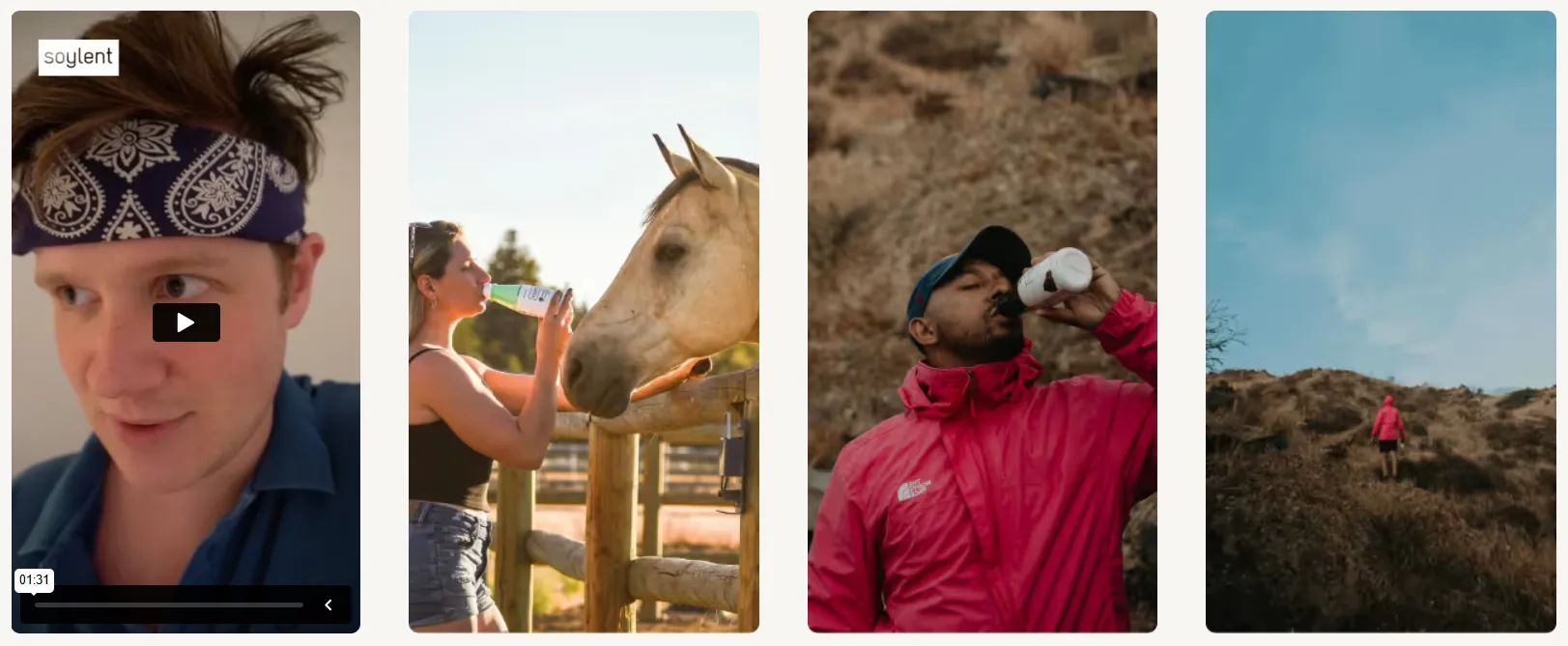
NielsenIQ: Lowering CPA with Micro-Influencers and Professional Relevance
This campaign used micro-influencers with the right niche, and it worked. NielsenIQ slashed its CPA by 75% and hit 100K+ monthly app downloads.
- Reach: Stacked smaller creators with targeted followings.
- Relevance: Focused on creators in analytics, productivity, and SaaS.
- Resonance: High click-through and install rates tied to referral codes.
Takeaway: With a tight audience match, you don’t need celebrity creators to scale performance.
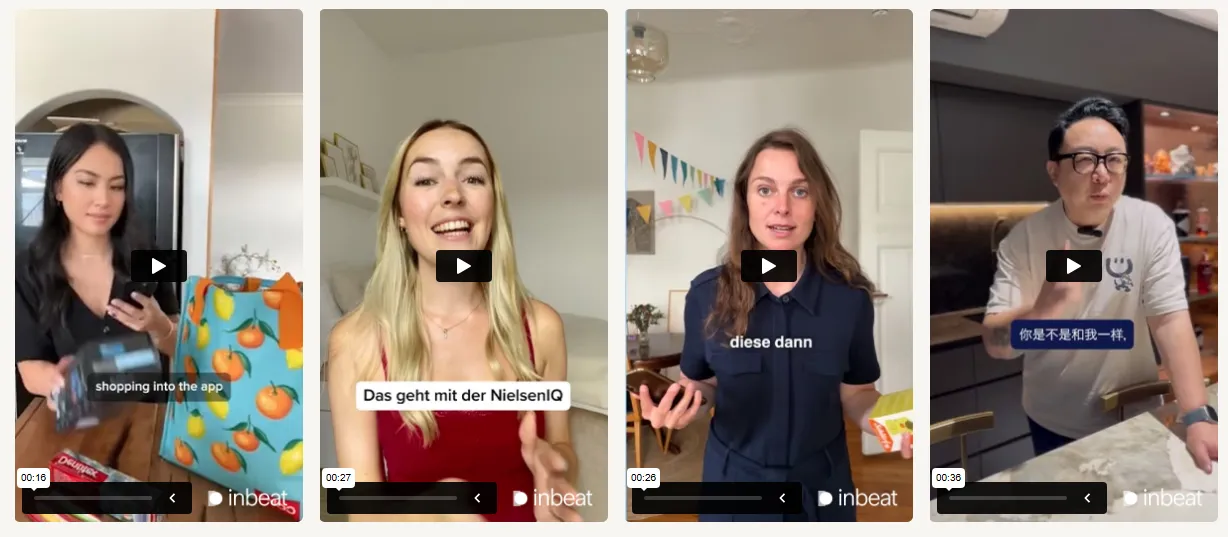
Launching a Music App Across LATAM with UGC
Now, let's think about a hypothetical case: If we were launching a new music app across Latin America, our approach would center on relevance and resonance, especially if the goal is to drive installs through UGC.
We’d tap into 40 micro and nano-creators across Mexico, Colombia, and Argentina, people already posting about music production, content creation, or creative tools. That ensures the content feels natural.
- Reach: Focused on regional creators with 10K–80K followers to get visibility without wasting impressions.
- Relevance: Every creator would already be active in the music or creator tech space.
- Resonance: We’d look for signs of real influence: quality comments, positive sentiment, and a history of driving clicks or downloads.
With the right mix, a single creator could easily drive over 1,000 installs within days. More importantly, the UGC from this type of campaign becomes a high-performing asset for paid media, landing pages, and future remarketing.
Takeaway: When you nail all 3 R’s, UGC looks good and drives installs (what we wanted to reach with our strategy).
How the 3 R’s Impact Different Types of Influencers
Not every influencer brings the same value to the table, and this is where a lot of campaigns go sideways.
You may pick a creator based on how many followers they have, without looking at how they perform across the 3 R’s.
Let’s break it down by creator tier and see how reach, relevance, and resonance typically show up in each one.
Mega or Celebrity Influencers
We’re talking about widely recognized names with millions of followers, major brand partnerships, and verified presence across every major platform.
- Reach is massive, which means visibility comes quickly, especially if your goal is media attention or generating social buzz.
- Relevance tends to be low unless the influencer already talks about or genuinely uses products in your category; without that connection, the partnership can feel disconnected or inauthentic.
- Resonance is often limited; while these influencers have their audience’s attention, they don’t always have their trust.
Engagement tends to be superficial, and most followers recognize these posts as paid promotions.
For example, NFL player Nick Bosa, with over 1.4 million Instagram followers, partnered with Hurom to promote its juicers. The reach alone was huge, but to boost relevance and resonance, Bosa tied the campaign to his personal story, sharing how juicing supported his recovery after an injury.
These influencers are best for:
- Large-scale brand awareness.
- Press mentions or event tie-ins.
- Sponsored partnerships where performance isn’t the main goal.
Watch out: This tier can eat your budget and leave you with vanity metrics. If performance is the priority, look elsewhere.
Macro-Influencers
These creators typically have between 100k and 500k followers. While they’re not celebrities, they’re well-known within their specific niche.
- Reach is solid and can scale well, making them a strong choice for building momentum at the top of the funnel.
- Relevance is often strong (particularly in focused categories like fitness, fashion, tech, or food) where their content aligns closely with the audience’s interests.
- Resonance can vary; some of these creators have built engaged, loyal communities, while others tend to prioritize volume and produce frequent sponsored content with less impact.
These are best for:
- Campaigns that mix awareness with engagement.
- Expanding into new audience segments.
- Testing products with creators who still feel approachable.
If you vet properly, macro-influencers can give you the best of both worlds: enough reach to matter, and enough trust to convert, if the relevance is there.
For example, Miro partnered with Chloe Shih, a LinkedIn Top Voice with over 102k followers, to launch The Product Manager Career Guide Template. This is a structured resource for aspiring and experienced PMs. Chloe’s deep experience at companies like Discord, Meta, TikTok, and Google gave the collaboration strong relevance, while her educational post walking through PM career paths added genuine resonance with tech professionals.
Micro-Influencers
Micro-influencers, typically with 10k to 50k followers, are the backbone of performance-driven influencer marketing.
- Reach is moderate but highly efficient; you might need to partner with several to achieve scale, but the audience quality often makes it worth it.
- Relevance tends to be high, as these creators usually stay focused on a specific niche, giving you access to a well-targeted and engaged community.
- Resonance is where they shine; this is typically where the most conversions happen, thanks to the trust and connection they’ve built with their followers.
inBeat has worked with several micro-influencers to deliver targeted, authentic campaigns. For example, Alyssa Klinzing, with 36,100 TikTok followers at the time of this writing, partnered with us on a TikTok ad for our client Bumble.
Her “GRWM for my first date” content felt personal and relatable, perfectly aligning with Bumble’s brand voice and resonating with users in the dating app’s target demographic.
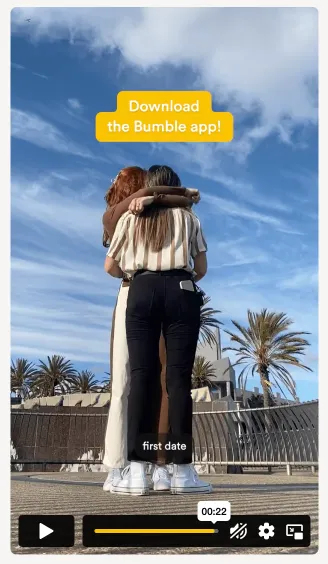
That said, micro-influencers are great for:
- DTC brands focused on ROI.
- UGC-style campaigns.
- Driving traffic, installs, or purchases.
Key Stat: Micro-influencers have strong engagement rates of around 2.4%. This is higher than mid-tier creators, which often means better conversions and real results.
Nano-Influencers
Nano-influencers, with 1k to 10k followers, may have smaller audiences, but their impact can be powerful. These creators are typically hyper-focused on a specific niche and deeply connected to their communities.
- Reach is limited, so you won’t get viral traction from a single post, but what you do get is highly targeted and intentional.
- Relevance is exceptionally strong, as these influencers frequently speak directly to the topics and interests your customers care most about.
- Resonance is where they excel; the content shared by nano-influencers tends to feel more like a personal recommendation than a paid promotion, which builds audience trust and drives genuine engagement. That's why these social media influencers can become your best brand ambassadors..
They’re best for:
- Local launches or niche markets.
- Building early brand trust.
- Social proof through authentic product reviews.
They’re affordable, real, and ideal for campaigns where quality of influence beats quantity of impressions.
By the way, inBeat is North America’s top nano-Influencer agency, trusted by brands that care about performance and reach.
Key Stat: Nano-influencers see 2.71% engagement, the highest of any tier. This proves that smaller but highly engaged communities can drive outsized results.
How to Apply the 3 R’s in a Real Campaign
Using the 3 R’s isn't just a nice idea; it’s how top-performing teams structure campaigns.
Whether you’re working with a handful of creators or scaling across multiple markets, this framework keeps things clean, consistent, and performance-focused.
Match the R’s to Your Funnel Stage
Each stage of the funnel calls for a different kind of creator strategy. Here's how it breaks down:
- Top of Funnel (TOFU) = Reach: You're trying to get noticed. Impressions matter most here. Think macro or mega influencers, broad appeal, and high-visibility content like Instagram Stories Ads or TikTok reach campaigns.
- Middle of Funnel (MOFU) = Relevance: Now, it's about getting your product in front of the right people. You want creators whose audience demographics match your buyer persona, whose tone fits your brand identity, and whose content style aligns with what your customers already consume.
- Bottom of Funnel (BOFU) = Resonance: This is where conversions happen. You need creators with actual influence, people whose followers trust their recommendations. UGC-style content, product reviews, affiliate codes, and strong CTAs work best here.
Pro tip: Start with a macro-influencer campaign to create buzz, and follow it up with targeted creators in your niche who can educate and engage. Then, finish with micro or nano-influencers who drive action with authentic, conversion-friendly content.
Spotting Red Flags in Influencer Profiles
Even with a solid process, the wrong creator can still slip through if you’re not watching for red flags.
Here’s what to avoid:
- High reach but no engagement: Could be fake followers or low content quality. Always check engagement stats.
- Aesthetic content but mismatched audience: Don’t assume visual quality = relevance. Look into who’s following and engaging.
- Generic or low-effort comments: “🔥🔥” and “Love this!” don’t mean much. You want thoughtful replies, questions, shares, and signals of real influence.
One common trap? Prioritizing reach and ignoring the other two R’s.
We’ve seen creators with 300K+ followers generate zero conversions, while a 15K nano-influencer brought in thousands of dollars in tracked sales.
As we already said, don't get distracted by vanity metrics.
Metrics That Matter for Each R
If you want campaigns that perform, you need to measure the right things.
- Reach:
- Follower base
- Post impressions
- Reach rate (reach/followers)
- Cross-platform reach (especially for multi-channel campaigns)
- Relevance:
- Audience demographics (location, age, interests)
- Category or niche alignment
- Brand collaborations in similar verticals
- Content style and tone match
- Resonance:
- Engagement rate (likes + comments / followers)
- Comment quality and sentiment
- Saves, shares, story replies
- Conversions (tracked via UTM links, referral codes, affiliate dashboards)
There are platforms that discover engines, combined with Instagram Insights or TikTok Creator Tools, that give you a clearer picture than a media kit ever will. If you're not tracking these metrics, you’re guessing, and guessing doesn’t scale.
Before You Spend Another Dollar: Run the 3 R’s
If your influencer strategy isn’t measuring the 3 R’s, you’re just guessing. And that’s how budgets quietly disappear.
The three R’s: Reach, Relevance, and Resonance, aren’t just a filter for picking creators. They’re a guide for how smart brands align their teams, grow faster, and stop spending on campaigns that don’t deliver.
And the most effective influencer campaigns? They’re not always the biggest. They’re the ones that hit the right R at the right moment, with creators who feel like a natural fit for your brand.
If you’re ready to bring this approach to life at scale, that’s where we come in.
At inBeat, we help performance-driven teams build lean, strategic influencer campaigns using vetted creators who deliver on all three fronts.
Let’s work together! Contact us today.
FAQs
What are the 3 R’s of Influencer Marketing?
Reach is the number of people a creator can expose your brand to, relevance is about how well their audience and content align with your brand, and resonance reflects the actual influence they have over their followers (measured through trust, engagement, and conversions). These three are core to any smart digital marketing strategy.
Why are the 3 R’s Important for Influencer Selection?
Because picking creators based on follower count alone doesn’t work. The 3 R’s help you vet creators based on what matters (visibility, fit, and actual influence) so you can drive better ROI and avoid campaign flops, especially in paid influencer partnerships where performance needs to be predictable.
Which of the 3 R’s Should You Prioritize for Performance Campaigns?
Resonance is the priority. You need creators whose audience genuinely trusts them, because trust is what leads to clicks, installs, purchases, and signups.
Right after that comes relevance. It ensures you're speaking to the right buyer persona and that your message lands with the people who matter, especially across different social media platforms where audience behavior varies.
Can a Creator be Strong in One ‘R’ and Still Fail Your Campaign?
Absolutely. For example, a creator with a huge reach but low resonance might get you impressions, but zero conversions. Or a niche-relevant influencer with no engagement? They’re just posting.
You want creators who bring a balanced mix, or at least dominate the “R” that matters most for your specific campaign goals.
Do Nano-influencers Have Strong Reach, Relevance, or Resonance?
Nano-influencers have limited reach, but high relevance and strong resonance. Their authenticity makes them ideal for early-stage brands, reviews, and tight-knit communities, especially when you need social media influencers who feel real and relatable.
Can Influencer Tools or Platforms Evaluate the 3 R’s For You?
Yes, but most tools are limited, so we recommend working with an agency, which would do a personalized evaluation for your specific case. When you're investing in content marketing, every creator needs to be aligned with your strategy, and not just with the metrics.
How Do You Apply the 3 R’s to UGC Creators?
Treat UGC creators like influencers. Even if they don’t post it, their user-generated content still requires reach, relevance, and resonance to perform and to stay usable across your funnel.
Are the 3 R’s Still Relevant with AI-generated Content on the Rise?
More than ever. As AI-generated content grows, with predictions saying 73% of influencer marketing could be AI-driven by 2030, authenticity will be the differentiator. The 3 R’s help you stay human and strategic in a space that’s becoming increasingly automated.

